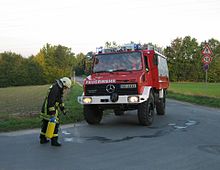Binding agent (hazard prevention)
Various binders are used in the area of hazard prevention . Essentially, a distinction can be made between oil and chemical binders.
Oil binding agent
Oil binders or oil binders are used to bind mineral oils by building yards , road maintenance depots and fire brigades . It should not be powdery or too fine-grained and can sometimes also be applied in a liquid state. The basic materials are mineral or plant-based substances (such as corn cobs ). There are also fleeces, snakes, cubes and much more to safely absorb oil in certain situations. There is also a buoyant oil binder, which is used in combination with oil barriers and oil rakes to remove mineral oils from water .
The most common area of application is the removal of leaking equipment after a traffic accident or traces of oil from cars with an open oil pan. Powdery oil binders used to sprinkle and remove the oil can significantly impair the sweeping ability of this mixture of oil with oil binder due to the formation of a smear, so that a permanent trace of oil binder cannot be avoided. Traces of oil binding agent must not be left in order to create slip resistance. When selecting a product, it is therefore important to ensure that the oil binding agent for traffic areas cannot generate dust from production to use, i.e. does not tend to form powdery components.
Chemical binders
For the inclusion of chemicals , there is a wide range of different chemical binder , including for use in industry, on traffic areas or in the waters. Pay particular attention to the correct selection. As a rule, they are also suitable for aggressive substances such as acids and alkalis. As universal binders, they can be used for such hazardous substances as well as for mineral oils. There are also special fleeces or snakes that are resistant to aggressive substances.
Accidents involving chemicals which are transported hot and which cool and solidify in the event of a leak are particularly problematic. Before these products with an oil binding agent can be absorbed, they must be dissolved with hot water generated at the accident site or with condensate brought in. This work can usually only be done by plant fire brigades with special equipment. The fire brigade control centers are happy to use the TUIS transport accident information system from the chemical industry , if available .
application
- Solid ground: The binding agent is scattered on the ground and then swept in or rubbed in with a sweeper, then swept up. The oil binding agent mixed with the hazardous substance must be completely absorbed before the end of the mission to prevent environmental damage to soil and water.
- Dissolve solidified products with hot water and absorb with binding agent, dump contaminated soil and send it to the manufacturer for disposal.
- Open waters: The buoyant binding agent is poured onto the water or oil barriers are applied. After it has absorbed the oil, it is collected again with the help of sieves or special rakes. Alternatively, there are skimmer systems .
Problems
The oil binding agent acquires the properties of the absorbed substance (hazardous waste) and must therefore be completely recovered, treated and properly disposed of. The ability of the oil binding agent mixed with oil to be removed, which is mandatory under waste law, can be significantly improved with the use of oil binding agents which, due to their mechanical strength, do not allow any powdery fine-grain components to develop and are consequently sweptable.
The porosity of oil binders makes them a catalyst for flammable liquids, as the larger surface area makes it easier to set a combustion reaction in motion ( wick effect ). Diesel is almost impossible to ignite with a lighter, but if an oil binding agent is put on it, this is possible without any problems. Due to the lower flash point , this risk is significantly higher with gasoline, which is why fire protection should always be ensured in such cases .
See also
literature
- Fire Brigade Coordination Switzerland FKS: Manual for NBC operations , Chapter 5.12.1 Binding of liquids , 2014.

